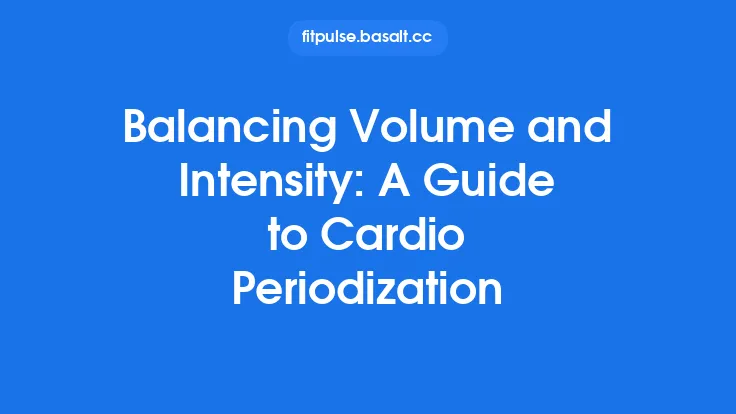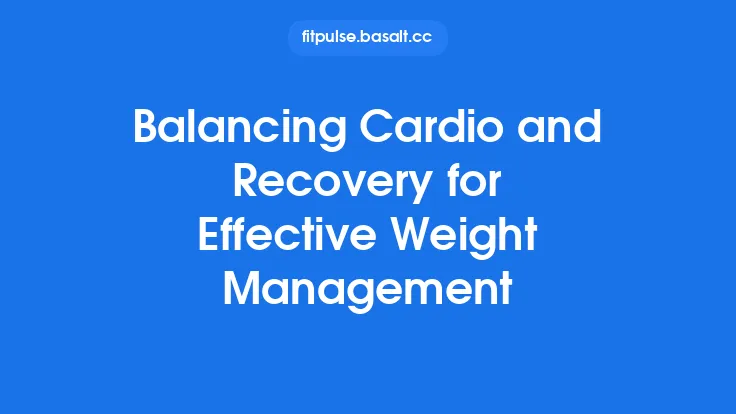The concept of periodization—systematically varying training load to elicit specific adaptations while minimizing fatigue—has long been a cornerstone of strength and power sports. In recent years, endurance athletes and coaches have embraced the same framework for cardio‑focused disciplines such as running, cycling, swimming, and rowing. By treating the year as a series of interconnected training blocks, you can deliberately shape volume (the total amount of work) and intensity (the relative effort of each session) to match physiological goals, competition schedules, and personal life demands. This approach not only maximizes performance peaks but also safeguards against overuse injuries, mental burnout, and the dreaded plateau.
Below is a comprehensive guide to periodizing cardio modality training throughout the calendar year. It walks you through the hierarchy of training cycles, the science behind volume‑intensity trade‑offs, and practical tools for monitoring progress—all while staying modality‑agnostic enough to apply to running, cycling, swimming, or rowing.
Understanding Periodization Principles
1. The Load Continuum
Training load can be expressed as the product of volume (e.g., total distance, duration, or number of repetitions) and intensity (e.g., speed, power output, heart‑rate zone). Shifting the balance along this continuum produces distinct physiological stimuli:
| Load Position | Primary Adaptation | Typical Session Characteristics |
|---|---|---|
| High Volume / Low Intensity | Aerobic base, mitochondrial density, capillarisation | Long, steady‑state efforts at 60‑70 % HRmax |
| Moderate Volume / Moderate Intensity | Aerobic threshold, lactate clearance | Tempo work, steady intervals at 75‑85 % HRmax |
| Low Volume / High Intensity | VO₂max, anaerobic capacity, neuromuscular power | Short intervals, sprints, high‑intensity bursts |
2. The Periodization Pyramid
A classic periodization model stacks training blocks from the most general (large volume, low intensity) to the most specific (low volume, high intensity). The pyramid’s layers are:
- Macrocycle – The full training year (or season) encompassing all phases.
- Mesocycle – 3‑6‑week blocks that target a particular adaptation.
- Microcycle – The weekly plan that distributes sessions, recovery, and testing.
3. Types of Periodization
- Linear – Gradual, monotonic shift from high volume/low intensity to low volume/high intensity.
- Undulating (or Non‑Linear) – Frequent (often weekly) fluctuations in intensity while maintaining overall volume.
- Block – Concentrated emphasis on a single quality (e.g., VO₂max) for a short, intense block, followed by a transition block.
Choosing a model depends on the athlete’s experience, competition frequency, and personal response to training stress.
Macrocycle Planning for Cardio Modalities
A typical macrocycle for endurance athletes can be divided into four overarching phases:
| Phase | Duration | Primary Goal | Volume‑Intensity Profile |
|---|---|---|---|
| Preparation (Base) | 12‑20 weeks | Build aerobic foundation, improve capillary density, develop efficient fuel utilization | High volume, low‑to‑moderate intensity |
| Build (Specific) | 8‑12 weeks | Raise lactate threshold, increase VO₂max, develop race‑pace efficiency | Moderate volume, moderate‑to‑high intensity |
| Peak (Competition) | 4‑8 weeks | Fine‑tune race‑specific speed, sharpen neuromuscular coordination, taper fatigue | Low volume, high intensity |
| Transition (Off‑Season) | 2‑4 weeks | Recovery, mental reset, address imbalances | Very low volume, mixed low intensity |
Seasonal Considerations
- Climate: Outdoor modalities (running, cycling, rowing) may require indoor alternatives during winter, influencing volume capacity.
- Competition Calendar: Align the peak phase with target races or events. If multiple key events exist, consider “double‑peak” macrocycles with two shorter build‑peak cycles.
- Life Events: Work, school, or travel can be built into the macrocycle as planned low‑load weeks.
Mesocycle Design: Balancing Volume and Intensity
Within each macro phase, mesocycles translate the broad goal into concrete training emphases. A typical mesocycle structure might look like this:
| Week | Focus | Sample Session Mix |
|---|---|---|
| 1 | Aerobic Endurance | 2 long steady sessions (70‑80 % HRmax), 2 easy recovery days |
| 2 | Threshold Development | 1 tempo interval (20‑30 min at lactate threshold), 1 moderate long run, 2 easy days |
| 3 | VO₂max/Power | 2 high‑intensity interval sessions (e.g., 5 × 3 min at 95 % HRmax), 1 easy long session |
| 4 | Recovery/Deload | Reduced volume (≈60 % of week 1) with low intensity, optional cross‑modal active recovery |
Key Mesocycle Variables
- Intensity Distribution: Use heart‑rate zones, power zones, or perceived exertion to prescribe effort. For swimming and rowing, consider stroke rate or power output as proxies.
- Volume Progression: Increment total weekly distance or duration by 5‑10 % per mesocycle, then drop 10‑20 % during a recovery week.
- Specificity: Align the dominant stimulus of the mesocycle with the upcoming competition demands (e.g., more interval work before a 5 km race, more long steady work before a marathon).
Microcycle Structure and Session Variables
A microcycle (usually a week) is the tactical level where day‑to‑day decisions are made. The following template can be adapted for any cardio modality:
| Day | Session Type | Duration/Distance | Intensity Cue |
|---|---|---|---|
| Monday | Recovery | 30‑45 min easy | ≤ 65 % HRmax |
| Tuesday | Interval | 8 × 400 m (or 2 min) | 90‑95 % HRmax |
| Wednesday | Moderate Endurance | 60‑90 min steady | 70‑75 % HRmax |
| Thursday | Technique/Skill (low load) | Drills, form focus (no heavy load) | Easy |
| Friday | Tempo | 20‑30 min at lactate threshold | 80‑85 % HRmax |
| Saturday | Long Endurance | 2‑3 h (or 80‑120 km) | 65‑75 % HRmax |
| Sunday | Rest or active recovery | Light cross‑training | ≤ 60 % HRmax |
Manipulating Session Variables
- Interval Length: Short (30‑60 s) intervals stress anaerobic power; longer (3‑5 min) intervals target VO₂max.
- Recovery Ratio: A 1:1 work‑to‑rest ratio favours aerobic conditioning; 1:0.5 pushes anaerobic capacity.
- Progressive Overload: Add one extra interval, increase distance by 5 %, or raise power output by 2‑3 % each week, then deload.
Modality‑Specific Considerations
While the periodization framework is universal, each cardio modality presents unique constraints that influence volume and intensity planning.
| Modality | Volume Metric | Intensity Metric | Practical Nuance |
|---|---|---|---|
| Running | Kilometers, minutes | Pace, heart‑rate zones, perceived effort | Impact forces dictate careful progression; consider surface variation to manage musculoskeletal load. |
| Cycling | Kilometers, hours, watt‑hours | Power zones (FTP), cadence, heart‑rate | Aerodynamic drag makes speed less reliable; power meters provide precise intensity control. |
| Swimming | Meters, laps | Stroke rate, pace per 100 m, heart‑rate (if available) | Water temperature and pool length affect perceived effort; use interval sets to control intensity. |
| Rowing | Meters, strokes, minutes | Power output (watts), stroke rate, heart‑rate | Rowing machines allow exact power tracking; on‑water sessions may require adjustments for wind and current. |
Key Takeaway: Choose the metric that best reflects physiological stress for the chosen modality and ensure it is consistently recorded for analysis.
Integrating Seasonal Factors and Competition Calendars
- Identify Anchor Events – Mark all target races, time trials, or performance tests on a calendar. These become the peaks of your macrocycle.
- Back‑Calculate Build Phases – From each anchor event, count back 8‑12 weeks to define the start of the build phase. Overlap build phases only if events are spaced > 6 weeks apart.
- Plan Transition Periods – After a major competition, schedule a 1‑2‑week active recovery followed by a 2‑week low‑volume transition before launching the next macrocycle.
- Adjust for Environmental Constraints – If winter limits outdoor mileage, substitute indoor sessions (e.g., treadmill, indoor bike, swim ergometer) while maintaining volume targets.
Monitoring, Testing, and Adjusting the Plan
1. Objective Metrics
- Heart‑Rate Variability (HRV) – Daily HRV trends can flag accumulating fatigue before performance drops.
- Power/Speed Threshold Tests – Conduct FTP (cycling), lactate threshold pace (running), or 400‑m time trial (swimming) every 4‑6 weeks.
- Training Load Scores – Use tools like Training Stress Score (TSS) or equivalent to quantify weekly load.
2. Subjective Measures
- RPE (Rate of Perceived Exertion) – Log RPE for each session; rising RPE at constant load signals insufficient recovery.
- Well‑Being Questionnaires – Sleep quality, mood, and muscle soreness provide early warning signs.
3. Adaptive Decision‑Making
- If Load ↑ & Performance ↓ → Insert an extra recovery day or reduce volume by 10‑15 %.
- If Load ↑ & Performance ↑ → Continue progression, perhaps increase intensity marginally.
- If Stagnation Over 3‑4 Weeks → Implement a “re‑load” week: lower volume, keep intensity high to stimulate fresh adaptation.
Recovery Strategies and Deload Weeks
Even the most meticulously periodized plan can falter without structured recovery.
- Planned Deloads: Every 4‑6 weeks, schedule a low‑volume week (≈ 60 % of normal volume) while maintaining moderate intensity to preserve fitness.
- Active Recovery Sessions: Light aerobic work (e.g., easy spin, easy swim) promotes circulation without adding stress.
- Sleep Hygiene: Aim for 7‑9 hours/night; prioritize consistent bedtime routines.
- Nutrition Timing: Post‑session carbohydrate‑protein ratios (3:1) accelerate glycogen restoration and muscle repair.
- Mobility & Soft‑Tissue Work: Incorporate foam‑rolling, dynamic stretching, or yoga on recovery days to maintain range of motion.
Common Pitfalls and How to Avoid Them
| Pitfall | Why It Happens | Countermeasure |
|---|---|---|
| Over‑emphasis on Volume | Belief that “more miles = better” | Use intensity zones to ensure a balanced load; cap weekly volume based on experience level. |
| Neglecting Individual Variability | One‑size‑fits‑all templates | Conduct baseline testing; adjust mesocycle progression based on personal response. |
| Skipping Recovery Weeks | Pressure to “keep training” | Schedule deloads in the calendar; treat them as non‑negotiable appointments. |
| Relying Solely on Pace | Pace can be affected by terrain, wind, or water conditions | Complement pace with heart‑rate or power data for a more objective intensity gauge. |
| Late‑Season Over‑Training | Desire to “finish strong” | Implement a taper 2‑3 weeks before the final target event; reduce volume while maintaining intensity. |
Putting It All Together: Sample Year‑Long Blueprint
Below is a condensed illustration of how the concepts can be assembled for an athlete targeting a spring marathon, a summer 40 km cycling event, and a fall 1500 m rowing race. The plan can be mirrored for other modality combinations.
| Period | Weeks | Primary Focus | Volume (Relative) | Intensity (Relative) | Key Sessions |
|---|---|---|---|---|---|
| Base 1 | 1‑12 | Aerobic endurance across all modalities | High (70‑80 % of max) | Low‑to‑moderate (60‑70 % HRmax / 55‑65 % FTP) | 3 long sessions (run/cycle/swim), 2 easy rows |
| Base 2 | 13‑20 | Build modality‑specific aerobic base | Moderate‑high | Low‑moderate | Introduce sport‑specific long sessions (e.g., 30 km bike ride, 2 km row) |
| Build 1 | 21‑28 | Marathon‑specific threshold work | Moderate | Moderate‑high (80‑85 % HRmax) | Weekly tempo run, bike threshold intervals |
| Peak 1 | 29‑32 | Marathon race | Low | High (90‑95 % HRmax) | 2‑3 race‑pace intervals, taper |
| Transition 1 | 33‑34 | Recovery | Very low | Easy | Light cross‑training, active recovery |
| Base 3 | 35‑44 | Re‑establish aerobic base for cycling | High | Low‑moderate | Long rides, easy rows |
| Build 2 | 45‑52 | Cycling VO₂max & power | Moderate | High (90‑95 % FTP) | 5 × 4 min VO₂max intervals, hill repeats |
| Peak 2 | 53‑56 | 40 km bike event | Low | High | Race‑specific simulation, taper |
| Transition 2 | 57‑58 | Recovery | Very low | Easy | Light swim, mobility work |
| Base 4 | 59‑66 | Rowing endurance & strength | Moderate‑high | Low‑moderate | Long rows, steady‑state pieces |
| Build 3 | 67‑72 | Rowing power & speed | Moderate | High (90‑95 % power) | 6 × 500 m high‑intensity rows |
| Peak 3 | 73‑76 | 1500 m rowing race | Low | Very high | Race‑pace pieces, taper |
| Off‑Season | 77‑80 | Full recovery & mental reset | Minimal | Easy | Non‑structured activity, hobbies |
Implementation Tips
- Data Logging: Use a single platform (e.g., TrainingPeaks, Strava) to capture all modalities for holistic load analysis.
- Flex Days: Reserve 1‑2 days per month as “flex” to accommodate life events without derailing the overall plan.
- Periodic Re‑Testing: After each peak, repeat the relevant threshold test to gauge progress and recalibrate training zones.
Closing Thoughts
Periodizing cardio modality training is more than a scheduling exercise; it is a science‑driven roadmap that aligns physiological stressors with performance goals across the entire year. By thoughtfully arranging macro‑, meso‑, and micro‑cycles, respecting the unique demands of each discipline, and continuously monitoring both objective and subjective markers, athletes can achieve sustained improvements while minimizing injury risk and burnout. Whether you’re preparing for a marathon, a century‑plus bike ride, a competitive swim meet, or a high‑intensity rowing race, the principles outlined here provide a flexible yet robust framework to guide you from the first stride to the final finish line.





